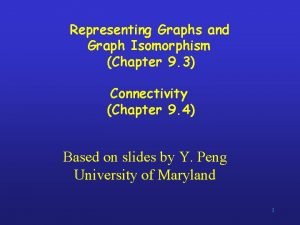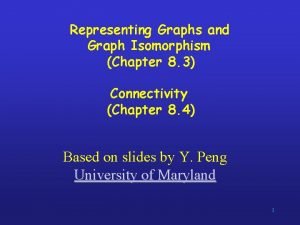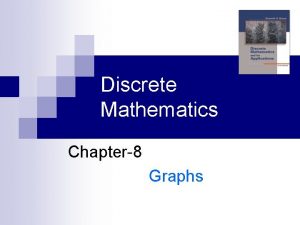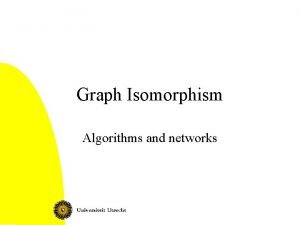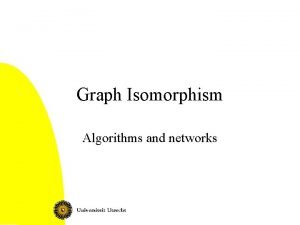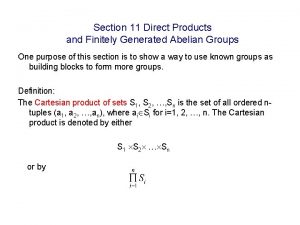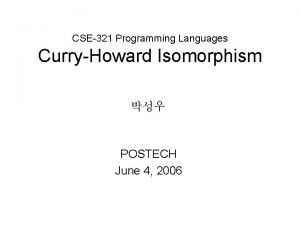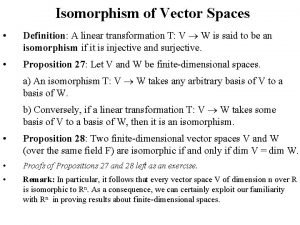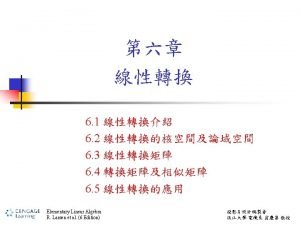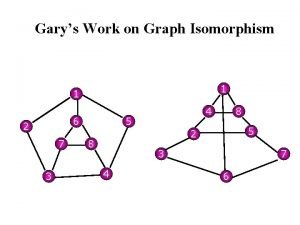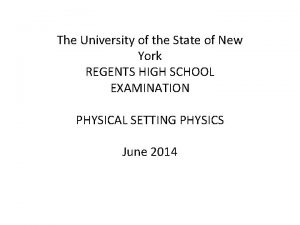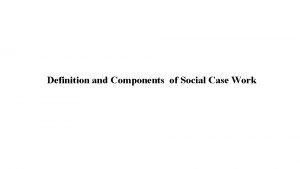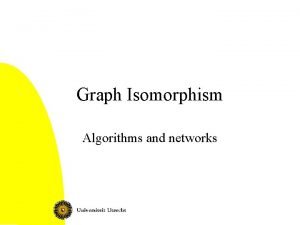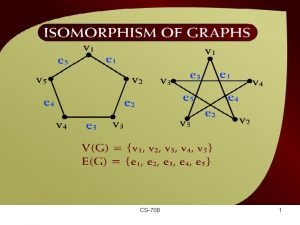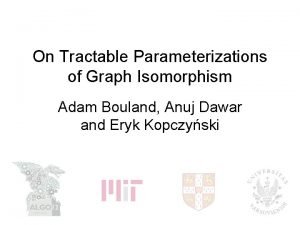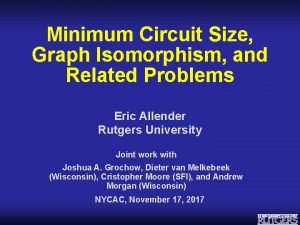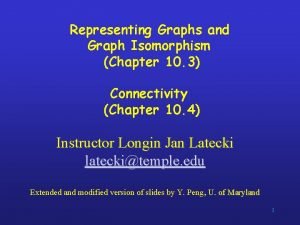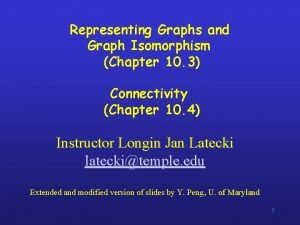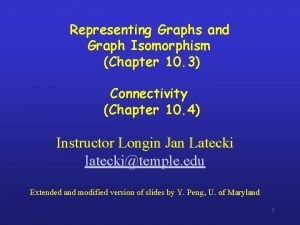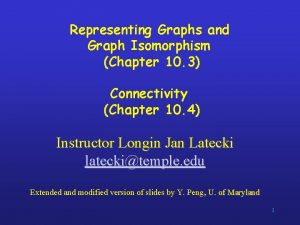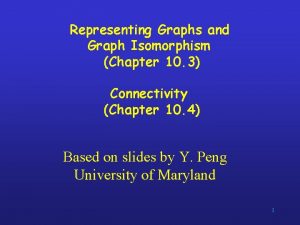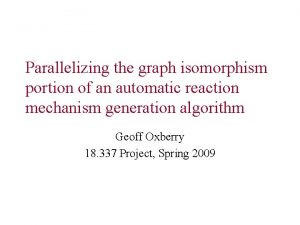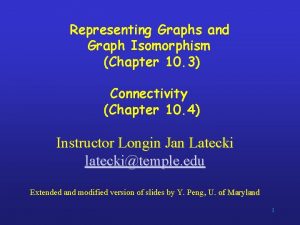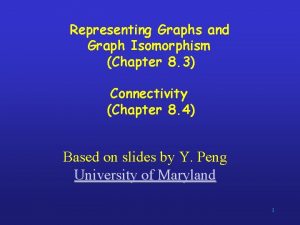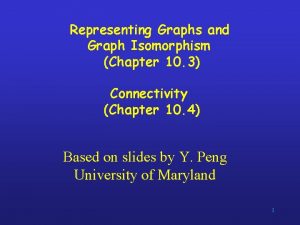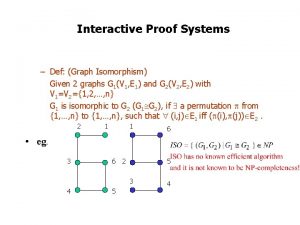Garys Work on Graph Isomorphism 1 1 6





















- Slides: 21

Gary’s Work on Graph Isomorphism 1 1 6 2 7 3 4 5 8 5 2 8 3 4 7 6

Gary’s Papers on Graph Isomorphism On the n log n isomorphism technique: a preliminary report. ACM STOC, 1978. Isomorphism testing for graphs of bounded genus. ACM STOC, 1980 Isomorphism of graphs which are pairwise k-separable. Information & Control, 1983. Isomorphism of k-contractible graphs: a generalization of bounded valence and bounded genus. Information & Control, 1983.

Gary’s Papers on Graph Isomorphism

Graph eigenvalues and eigenvectors 2 1 3 5 4 0 1 1 0 1 0 0 1 1 0 0 1 0

Graph eigenvalues and eigenvectors 2 0 1 -1 1 3 5 4 -1 1 node = sum of nbrs -2(-1)=(1+1) -2 1 0 -1 -1 1 = 0 1 1 0 1 0 0 1 1 0 0 1 0 -1 -1 1

Graph eigenvalues and eigenvectors 2 0 1 -1 1 3 5 4 -1 1 -2 1 0 -1 -1 1 = 0 1 1 0 1 node = sum of nbrs Are up to n eigenvalues, invariant under relabeling of vertices 1 0 0 1 1 0 0 1 0 -1 -1 1

Graph eigenvalues and eigenvectors 4 0 1 -1 5 1 2 3 -1 1 -2 -1 -1 1 0 1 = 0 0 1 1 1 0 0 0 node = sum of nbrs Are up to n eigenvalues, invariant under relabeling of vertices eigenvalues different -> graphs different 1 0 0 0 1 1 1 0 -1 -1 1 0 1

Graph eigenvalues and eigenvectors 4 0 1 -1 5 1 2 3 -1 1 -2 -1 -1 1 0 1 = 0 0 1 1 1 0 0 1 When are n eigenvalues, each has one-dimensional eigenspace: (cv) = A(cv) Can fix v to have norm 1, but cannot normalize sign 1 1 0 0 0 1 1 1 0 -1 -1 1 0 1

Testing isomorphism when G and H have same eigenvalues Compute eigenvectors of G: v 1, v 2, …, vn and eigenvectors of H: u 1, u 2, …, un Goal: Label vertex i by v 1(i), v 2(i), …, vn(i) But, eigenvectors only determined up to sign.

A Delaunayed Gary

Embedding of graph using two eigvecs v 3(i) v 2(i)

If use v 2(i), v 3(i) as label of vertex i determined up to flips in sign of eigvecs

Testing isomorphism when G and H have same eigenvalues Isomorphic iff are signs s. t. set of labels are same. v 1: . 50 v 2: -. 43 v 3: . 50 v 4: . 18 v 5: . 53 § u 1: § u 2: § u 3: § u 4: § u 5: 0 -. 50. 74 -. 43. 12 0 -. 50. 52. 18 -. 58. 43. 53. 36 -. 50 -. 12. 50 -. 58. 36 . 50 -. 50 0. 43 -. 74. 50 -. 50 0. 18. 52. 53. 43 l 1 = -2. 0000 l 2 = -1. 1701 l 3 = 0. 0000 l 4 = 0. 6889 l 5 = 2. 4812 label of node 2

Distinguish verts when labels allow. Make signs cannonical when possible. v 1: . 50 v 2: -. 43 v 3: . 50 v 4: . 18 v 5: . 53 0 -. 50. 74 -. 43. 12 0 -. 50. 52. 18 -. 58. 43. 53. 36 Can only map to each other § u 1: § u 2: § u 3: § u 4: § u 5: -. 50 -. 12. 50 -. 58. 36 . 50 -. 50 0. 43 -. 74. 50 -. 50 0. 18. 52. 53. 43

Distinguish verts when labels allow. Make signs canonical when possible. v 1: . 50 v 2: -. 43 v 3: . 50 v 4: . 18 v 5: . 53 0 -. 50. 74 -. 43. 12 0 -. 50. 52. 18 -. 58. 43. 53. 36 Can only map to each other Fix signs so that labels are same § u 1: § u 2: § u 3: § u 4: § u 5: -. 50 -. 12. 50 -. 58. 36 . 50 -. 50 0. 43 -. 74. 50 -. 50 0. 18. 52. 53. 43

Distinguish verts when labels allow. Make signs canonical when possible. v 1: . 50 v 2: -. 43 v 3: . 50 v 4: . 18 v 5: . 53 0 -. 50. 74 -. 43. 12 0 -. 50. 52. 18 -. 58. 43. 53. 36 Can only map to each other Fix signs so that labels are same § u 1: § u 2: § u 3: § u 4: § u 5: -. 50. 50 -. 50. 12 -. 43. 50 -. 58. 18. 36. 53 0. 74 0. 52. 43

More formally, Partition vertices into classes, initially by |vk(i)| If some class has more positive than negative entries in a vk, make sign canonical. (2, -2, 1, 1, 1, -1, -1) Partition vertices into classes by vk(i), for vk with canonical signs.

More formally, Partition vertices into classes, initially by |vk(i)| If some class has more positive than negative entries in a vk, make sign canonical. (2, -2, 1, 1, 1, -1, -1) Partition vertices into classes by vk(i), for vk with canonical signs. Do same for all products vk 1(i)*vk 2(i)*. . . *vkr(i)

For all products? Either vk (i)*. . . *vk (i) 1 2 r splits class: v 1: 1 1 -1 -1 v 2: 1 1 -1 -1 1 1 v 3: 1 -1 1 1 -1 -1 v 3: 1 -1 -1 or vkr = product of some of vk 1*vk 2*. . . *vkr-1 on that class. v 1: 1 v 2: 1 v 4: 1 1 -1 -1 1 1 1 -1 -1 v 4 = v 1 v 2

When finished All classes have form v 1: 1 v 2: 1 v 4: 1 1 -1 -1 1 1 1 -1 -1 v 4 = v 1 v 2 Can solve for all automorphisms of G, and all isomorphisms of G and H by linear eqns over GF(2)

What about high eigenvalue multiplicity? Worst case: Strongly regular graphs Are two general families: Latin Square graphs and Steiner Triple Systems On the n log n isomorphism technique: a preliminary report. ACM STOC, 1978.
 Representing graphs and graph isomorphism
Representing graphs and graph isomorphism Representing graphs and graph isomorphism
Representing graphs and graph isomorphism Working memory graphs
Working memory graphs Graph isomorphism
Graph isomorphism Graph isomorphism network
Graph isomorphism network Find all abelian groups (up to isomorphism) of order 360.
Find all abelian groups (up to isomorphism) of order 360. Isomorphism
Isomorphism Color 01252005
Color 01252005 Left multiplication transformation
Left multiplication transformation Isomorphism
Isomorphism Identity linear transformation
Identity linear transformation Isomorphism
Isomorphism Isomorphism svenska
Isomorphism svenska Handshaking theorem
Handshaking theorem Wait-for graph
Wait-for graph A 25 gram paper cup
A 25 gram paper cup Work immersion ethics
Work immersion ethics Objectives work immersion
Objectives work immersion Hard work vs smart work presentation
Hard work vs smart work presentation Works present simple
Works present simple Social group model
Social group model Components of social case work ppt
Components of social case work ppt
